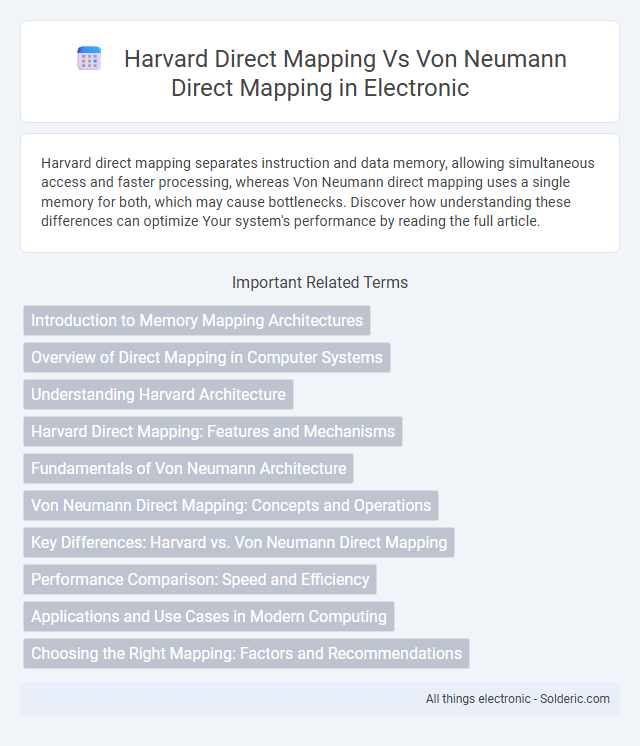Harvard direct mapping separates instruction and data memory, allowing simultaneous access and faster processing, whereas Von Neumann direct mapping uses a single memory for both, which may cause bottlenecks. Discover how understanding these differences can optimize Your system's performance by reading the full article.
Comparison Table
| Feature | Harvard Direct Mapping | Von Neumann Direct Mapping |
|---|---|---|
| Architecture | Separate memory for instructions and data | Unified memory for instructions and data |
| Memory Access | Simultaneous access to instruction and data memory | Single access port, alternate instruction/data fetch |
| Cache Structure | Separate instruction and data caches | Single combined cache for instructions and data |
| Mapping | Direct mapped independently for instruction and data | Direct mapped unified cache |
| Performance | Higher throughput due to parallel instruction/data access | Lower throughput, resource conflicts possible |
| Complexity | More complex control logic, increased hardware cost | Simpler, cost-effective hardware design |
| Use Cases | Embedded systems, DSPs demanding high speed | General-purpose CPUs, simpler systems |
Introduction to Memory Mapping Architectures
Harvard direct mapping architecture separates instruction and data memory, enabling simultaneous access and reducing memory bottlenecks in embedded systems and signal processing applications. Von Neumann direct mapping uses a single memory space for both instructions and data, simplifying design but potentially causing access conflicts and slower execution speeds. Your choice between these architectures affects system performance, memory access speed, and overall efficiency in computing tasks.
Overview of Direct Mapping in Computer Systems
Direct mapping in computer systems is a cache memory technique assigning each main memory block to a specific cache line, optimizing data retrieval speed. Harvard architecture separates instruction and data caches, enabling simultaneous access and reducing bottlenecks, while Von Neumann architecture uses a unified cache for both, simplifying design but potentially causing access conflicts. This distinction affects system performance, with Harvard's direct mapping improving parallelism and Von Neumann's approach favoring simplicity in memory management.
Understanding Harvard Architecture
Harvard architecture features separate memory spaces for instructions and data, enabling simultaneous access that boosts processing speed compared to the unified memory of Von Neumann architecture. Direct mapping in Harvard architecture facilitates parallel instruction and data retrieval by utilizing distinct cache structures, reducing bottlenecks caused by shared address buses. This separation enhances system performance in embedded systems and digital signal processors where real-time processing is critical.
Harvard Direct Mapping: Features and Mechanisms
Harvard direct mapping separates instruction and data memory, enabling simultaneous access through independent caches, which enhances processing speed and efficiency. This architecture utilizes distinct address spaces and buses for instructions and data, reducing memory access conflicts and increasing throughput. Your system benefits from Harvard direct mapping by achieving faster execution cycles and improved cache management compared to Von Neumann architecture.
Fundamentals of Von Neumann Architecture
The Von Neumann architecture is characterized by a single memory space that stores both data and instructions, leading to a unified address and data bus system which creates a bottleneck known as the Von Neumann bottleneck. In contrast, Harvard architecture employs separate memories and buses for instructions and data, enabling simultaneous access and improved throughput. Your understanding of Von Neumann direct mapping highlights its sequential access nature, impacting data retrieval speed compared to the parallelism possible in Harvard direct mapping systems.
Von Neumann Direct Mapping: Concepts and Operations
Von Neumann direct mapping utilizes a single memory space for both instructions and data, allowing your system to access them sequentially through a shared bus, which simplifies hardware but can lead to bottlenecks. This architecture relies on the program counter to fetch instructions and the memory address register to handle data, making pipeline efficiency highly dependent on access speed. Efficient management of memory allocation and careful synchronization of instruction and data fetching are key to optimizing Von Neumann systems' direct mapping performance.
Key Differences: Harvard vs. Von Neumann Direct Mapping
Harvard direct mapping separates instruction and data caches, allowing simultaneous access and improving processing speed, whereas Von Neumann direct mapping uses a single shared memory for both, which can create bottlenecks during simultaneous read/write operations. The Harvard architecture optimizes parallelism by physically distinct memory pathways, while Von Neumann relies on a unified memory bus that sequentially handles data and instructions. Understanding these key differences helps you design memory systems tailored to specific performance and complexity requirements in computing.
Performance Comparison: Speed and Efficiency
Harvard direct mapping separates instruction and data caches, enabling parallel access that significantly enhances speed and overall efficiency compared to Von Neumann direct mapping, which uses a single memory space for both, causing potential bottlenecks. You benefit from Harvard architecture's reduced latency and higher throughput, especially in real-time or high-performance computing applications. Von Neumann's simplicity comes at the cost of slower data fetching and increased instruction execution time.
Applications and Use Cases in Modern Computing
Harvard direct mapping is predominantly applied in embedded systems and digital signal processing where separate memory for instructions and data enhances performance and security. Von Neumann direct mapping is commonly used in general-purpose computing due to its unified memory architecture, simplifying design and memory management. Your choice depends on the application demands, with Harvard architecture excelling in speed-critical tasks and Von Neumann favored for versatile computing environments.
Choosing the Right Mapping: Factors and Recommendations
Choosing the right mapping between Harvard direct mapping and Von Neumann direct mapping depends on factors such as memory access speed, system complexity, and application requirements. Harvard architecture offers separate instruction and data caches, enabling faster parallel access and improved performance in real-time systems, while Von Neumann architecture simplifies design by using a single memory space but may introduce bottlenecks. Systems prioritizing speed and efficiency benefit from Harvard mapping, whereas cost-sensitive or simpler embedded systems often adopt Von Neumann direct mapping for its straightforward implementation.
Harvard direct mapping vs Von Neumann direct mapping Infographic

 solderic.com
solderic.com